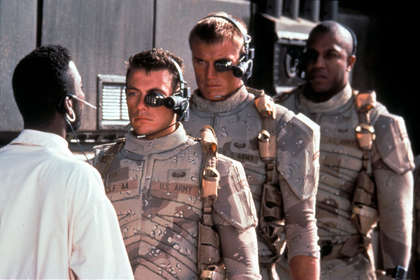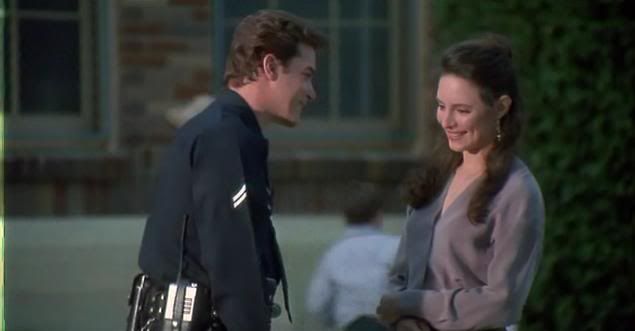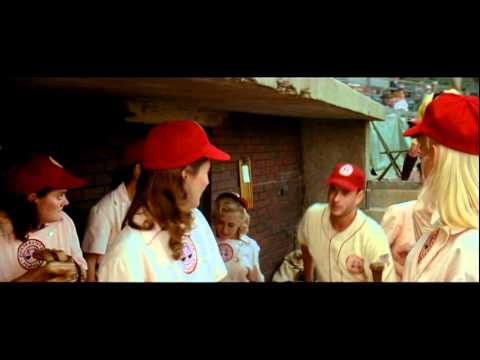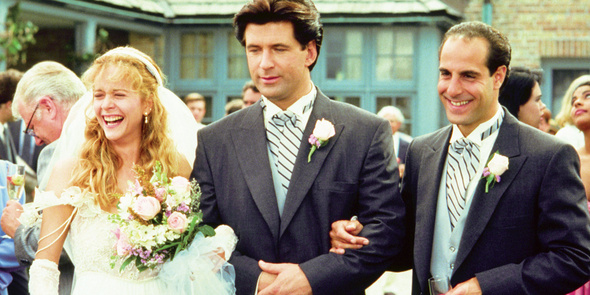From the Chicago Reader (July 17, 1992). — J.R.
UNIVERSAL SOLDIER
** (Worth seeing)
Directed by Roland Emmerich
Written by Richard Rothstein, Christopher Leitch, and Dean Devlin
With Jean-Claude Van Damme, Dolph Lundgren, Ally Walker, Ed O’Ross, Jerry Orbach, Leon Rippy, Tico Wells, and Ralph Moeller.
UNLAWFUL ENTRY
** (Worth seeing)
Directed by Jonathan Kaplan
Written by Lewis Colick, George D. Putnam, and John Katchmer
With Kurt Russell, Ray Liotta, Madeleine Stowe, Roger E. Mosley, Ken Lerner, Deborah Offner, Carmen Argenziano, and Andy Romano.
A LEAGUE OF THEIR OWN
** (Worth seeing)
Directed by Penny Marshall
Written by Lowell Ganz and Babaloo Mandel
With Geena Davis, Madonna, Lori Petty, Tom Hanks, Jon Lovitz, David Strathairn, Garry Marshall, Megan Cavanagh, and Rosie O’Donnell.
PRELUDE TO A KISS
** (Worth seeing)
Directed by Norman Rene
Written by Craig Lucas
With Alec Baldwin, Meg Ryan, Sydney Walker, Ned Beatty, Patty Duke, Kathy Bates, and Richard Riehle.
Out of all the genres represented by this summer’s crop of movies, there are at least three that haven’t yet been officially recognized. There are sequels like Lethal Weapon 3 and Batman Returns whose true genres are not so much old-fashioned categories like police thriller and fantasy adventure as “this summer’s Lethal Weapon movie” and “this summer’s Batman movie.” Then there are strictly-by-the-book imitations like Universal Soldier and Unlawful Entry whose true genres are not so much science-fiction action adventure or romantic horror thriller as “this summer’s Terminator rip-off” and “this summer’s Fatal Attraction rip-off.” Finally, there are movies that, consciously or not, represent throwbacks to genres or cycles of other eras — specifically A League of Their Own, which resembles 40s musicals, and Prelude to a Kiss, which resembles supernatural comedies and dramas of the early 40s.
All of this, I realize, is open to debate. (There will be those who insist that A League of Their Own is “this summer’s baseball picture” and Prelude to a Kiss is “this summer’s Ghost,” for instance.) But the bottom line is that the categories used to classify movies in video rental outlets no longer seem adequate — assuming that they ever were — to what is in front of us.
As a corollary to this proposition, we might start thinking about what it actually means to be “this summer’s Batman movie.” To call Batman Returns a fantasy adventure doesn’t really account for why even many adults who dislike it feel obliged to pay it fealty, intellectually as well as financially. Fifteen years ago, it was appalling that George Lucas’s imitating a shot from Leni Riefenstahl’s Nazi propaganda film Triumph of the Will in Star Wars gave him certain academic credentials in the eyes of many intellectuals, the shot supposedly making the movie better, not worse. And now that the New York Times has run an op-ed piece by a couple of college students entitled “Batman and the Jewish Question,” the intellectual stock of the picture seems to have gone up about 200 percent. Although for reasons best known to themselves, the authors take care to state early on that “Batman Returns is not anti-Semitic,” they also have the following to say about the Penguin, whom they persuasively describe as a racist Jewish stereotype: “He spends long hours in the archives compiling lists of first-born sons. Though clearly a reference to the final plague in Exodus, it is also an echo of the accounts of Nazis and anti-Semites throughout history as well as reinforcing the myth that Jews drink the blood of gentile children.” In other words, one might conclude — judging from this article and the current intellectual climate — that the movie might be utterly boring and pretentious, but because it may have been influenced by The Protocols of the Elders of Zion it deserves our respect.
Turning to the four pictures under review, one should note that it’s a lot easier to imitate a recent hit than it is to emulate a forgotten genre. There’s so much confusion about the past in most people’s minds nowadays that drawing from it in any intelligent or intelligible way is bound to lead to trouble. (For instance, I would hazard the guess that many teenagers assume that the term film noir had currency in the U.S. in the 40s, not realizing that it was imported decades after films we describe as such were made.) Consequently it might be said that Universal Soldier and Unlawful Entry are smoother and more consistent as commercial entertainments than A League of Their Own or Prelude to a Kiss because they attempt so much less; they may be less adventurous, but at least in a mechanical sense they can be said to deliver the goods.
A certain amount of dark humor underlies the conceptions of both Universal Soldier and Unlawful Entry, but you’d have to have seen other recent movies that define their contexts to appreciate the wit. Part of the humor in Universal Soldier derives from an axiom already established in The Terminator: take a dumb-looking, inexpressive, muscle-choked star — Arnold Schwarzenegger in The Terminator, both Jean-Claude Van Damme and Dolph Lundgren here — and turn him into a futuristic machine without emotions and immune to pain, and his liabilities convert to assets.
The chief difference is that the Terminator was never human to begin with; Van Damme and Lundgren both play grunts killed in Vietnam who, years later as part of a secret Pentagon project, are resurrected as nearly impregnable killing machines. Lundgren’s character is a paranoid, xenophobic racist who wears a necklace of human ears and wants to kill every Vietnamese in sight; Van Damme’s character dies while trying to prevent him from killing a couple of Vietnamese peasants. Twenty-five years later, refashioned as UniSols, short for “universal soldiers,” they begin to break loose from their human commanders when their former personalities are restimulated. Lundgren, who thinks he’s still fighting in Vietnam — an acerbic comment on this country’s regressive tendencies — takes off after Van Damme, who simply wants to go home and see his folks. The remainder of the movie is devoted to the chase and the bouts of carnage that occur whenever Lundgren and the other UniSols and/or their human commanders catch up with him.
Both Van Damme and Lundgren are about as interesting as soup cans, so the main appeal of the picture is waiting for these soup cans to puncture or flatten each other in ever more horrific ways. The neo-fascist pleasure of watching destruction on a grand scale is exploited here by such sequences as Van Damme and the TV news reporter he hooks up with (Ally Walker) crashing through the successive walls of a row of motel rooms and Lundgren throwing hand grenades from an enormous truck as he chases Van Damme and the reporter in a bus around the edge of what looks like the Grand Canyon. The results offer only a fraction of the imagination and filmmaking skill found in The Terminator — which was itself a partial rip-off of Blade Runner and various cyberpunk novels. But after all, if “this summer’s Terminator rip-off” is what we’re willing to settle for, it hardly matters.
While The Terminator seems worthy of limited respect, Fatal Attraction — a machine built to exploit yuppie xenophobia, glibness, and misogyny, and the model for Unlawful Entry — deserves only the most thoroughgoing contempt. I’m not much fonder of Lethal Weapon 3, a celebration of Los Angeles police brutality and large-scale explosions that is still fairly high on the box-office charts. My highly circumscribed respect for Unlawful Entry is largely, in fact, a function of my dislike of these two other movies, so if you haven’t seen either Fatal Attraction or Lethal Weapon 3, you may not share my reactions.
Broadly speaking, Unlawful Entry takes Fatal Attraction‘s fear and loathing of independent single women as potential desecraters of yuppie property and space and turns this into a fear and loathing of violent white LA cops as potential desecraters of yuppie property and space. This is obviously given more of an edge by the brutal Rodney King incident and subsequent rioting. Despite the unlikely alliance between white yuppie and minority interests, the fact remains that the psychotic cop (Ray Liotta) in Unlawful Entry winds up beating or killing a fair number of blacks in the course of romantically pursuing the white heroine (Madeleine Stowe) and trying to get rid of her husband (Kurt Russell) (although, as with Robert De Niro in Taxi Driver, the movie avoids overtly identifying the cop as a racist). The movie seems calculated to make one feel profoundly uneasy about the power of policemen — in striking contrast to Lethal Weapon 3, which is little more than a celebration of that power, and moreover masks the nature and degree of its violence to blacks.
It could be argued, of course, that Unlawful Entry exploits an audience’s fears every bit as shamelessly as Fatal Attraction does, just as one could argue that the pleasure taken in large-scale destruction in Universal Soldier is not really so different from the photogenic explosions in Lethal Weapon 3. I concede both these points and would agree that all four films offer fairly low forms of entertainment. But I also get more pleasure from the exploitation of hatred for LA cops than from the exploitation of hatred for single women or from the celebration of violent LA cops. It might be argued, too, that the uneasiness about both cops and home security systems (we perceive that “protection” can easily turn into imprisonment) inspired by Unlawful Entry could encourage reflection about some of our own casual assumptions, while uneasiness about single women and casual sex isn’t likely to provoke much thought of any kind. Similarly, the destruction of motel walls in Universal Soldier is more enjoyable — and funnier — than the blowing up of an entire skyscraper in Lethal Weapon 3, even though the latter is more impressive visually. By the same token, I find the disgust for people in general in Batman somewhat more entertaining than the disgust for Jews in particular in Batman Returns.
Although they occasionally stumble over gags or plot points, these action pictures appear to know what they’re doing most of the time. This is less true of A League of Their Own and Prelude to a Kiss, which are often klutzy and uncertain; both seem too long, not only slow in getting started but also in winding to a close. But I tend to prefer them to the actioners in spite of their misjudgments because their goals are both more ambitious and less venal. After all, you can’t stumble if you don’t try to walk, and these are movies that actually want to go somewhere.
The fact that they both recall unexceptional genre pictures of the early 40s might make them seem limited, but for me this means that they unfold in a bigger world than the present, not a smaller one. Most of A League of Their Own is set in 1943, when movies were still being made for entire families rather than just kids or teenagers or young adults. You might also say that movies were then being made for entire communities — small towns and city neighborhoods all across the country — and were often about entire communities.
Consciously or not, A League of Their Own, about the All American Girls Professional Baseball League, seems to follow that loose model. It reminds me of routine wartime musicals — not special efforts like The Gang’s All Here or Cabin in the Sky or Girl Crazy or The Sky’s the Limit, but those wholly forgettable Betty Grable and Alice Faye vehicles, top-heavy with running gags, dopey character actors, corny subplots, and sentimental framing devices. A League of Their Own isn’t a musical, but the narrative layout resembles one in many ways, from the recruitment of players/performers to training/rehearsals to individual games/shows to bus rides between engagements, and there are similar shifts of focus between the leads (in this case Geena Davis and Tom Hanks) and the second bananas (Madonna and Lori Petty) and various comic turns (Jon Lovitz, Garry Marshall, Megan Cavanagh, Rosie O’Donnell). It’s entirely consistent with this tradition that the dialogue is full of cliches, that Madonna should play a character who’s just like her onstage persona rather than an independent creation, and that Hanks as the manager should start out obnoxious, grumpy, and apathetic and wind up serious, caring, and affectionate.
Hanks’s strident overplaying during his character’s obnoxious phase is just one example of director Penny Marshall’s bad judgment; there are many others. Most of the misjudgments in Prelude to a Kiss, on the other hand, can probably be traced to the decision to film Craig Lucas’s play in the first place, rather than to any infelicities on the part of director Norman Rene (who also directed the New York production). Lucas’s introductory note to the play indicates a spare use of stage furnishings, a strategy that seems entirely appropriate to stimulating an audience’s collective imagination and getting them to agree to share the story’s fantasy premises with the author, director, and actors. Spare sets don’t work the same way in movies, making it understandable that this film version ignores the dictum, but any collective agreements engendered by the story and characters won’t be the same either. At best one can be charmed rather than captured by the fantasy premise — remaining on the outside looking in. (I think I may have benefited, however, from not knowing this premise before I saw the movie, so some readers may prefer to stop reading here.)
The first half of Prelude to a Kiss is a fairly simple and touching urban love story — set in New York in the play, in Chicago in the movie — that is kept simple as well as touching through the two leads, Alec Baldwin (as Peter) and Meg Ryan (as Rita). The fantasy premise — slow in arriving and even slower in becoming clear to the audience — involves the transmigration of souls, and occurs at the couple’s outdoor wedding, at the suburban home of Rita’s parents (Ned Beatty and Patty Duke). An unidentified old man (Sydney Walker) who has arrived at the ceremony — and who, we eventually discover, is dying of both cancer and cirrhosis of the liver — asks to kiss the bride, and when he does so their souls trade places.
Peter gradually becomes aware of the change during the honeymoon in Jamaica, when it slowly emerges that the Rita he married is different from the Rita he fell in love with. Back in Chicago the couple separates and it is only after this occurs that we discover the transmigration of souls and how it took place. (Apparently both the old man and Rita willed it to happen — though Rita’s motivation remains pretty obscure, at least to me, and one of the movie’s failures is its vagueness on this point.)
It’s a story that seems made for stage magic — which means that without a stage it’s clearly out of its element. The overall curve of the story telling is muddled by a performance from Meg Ryan that keeps us uncertain for much too long about whether her husband Peter is losing his mind or she’s really no longer Rita. Perhaps the uncertainty is intentional, but if so it’s misguided: by the time we discover what’s going on we’re somewhat disengaged, and the charisma of the two leads can only partially succeed in winning us back.
It’s mainly a fluke — and by virtue of its being an adaptation of a play — that Prelude to a Kiss should resemble a supernatural movie of the early war years. Unlike other films of this category however — The Devil and Daniel Webster and Here Comes Mr. Jordan (1941), I Married a Witch and Cat People (1942), Cabin in the Sky and Heaven Can Wait (1943) — it lacks the folkloric and metaphysical trimmings, the evocations of heaven and hell and the historical past that play decisive roles in furnishing the fantasies. And the context of wartime deaths that informed the spirituality of those films is obviously missing as well.
Perhaps significantly, the Duke Ellington ballad that gives this movie its title dates from the late 30s, the period immediately preceding the war. But Prelude to a Kiss shares with those early 40s romances a certain atemporal ambience and a purity in its treatment of love, which is central to its charm. It harks back to a time in movies when one could speak about love and souls without embarrassment or gimmicks or Spielberg lighting, and for this reason alone it deserves a look.




